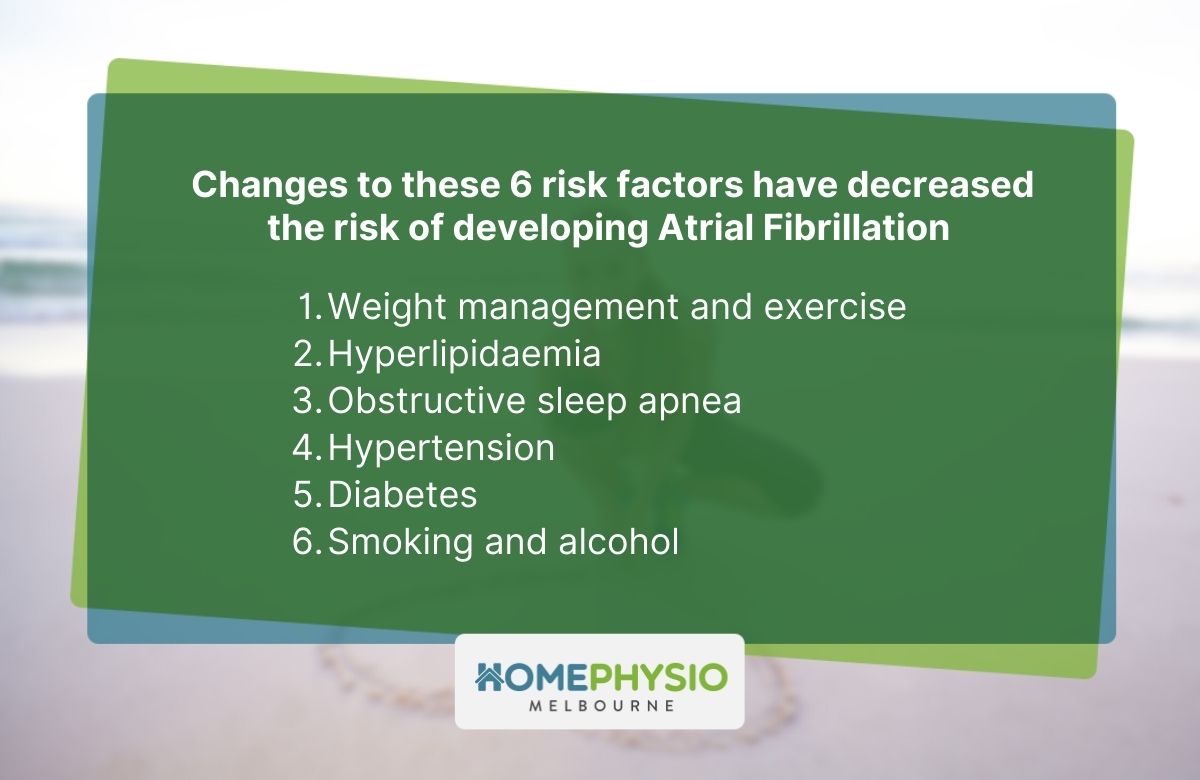Having atrial fibrillation (AF) can be a frightening experience. You may have an irregular heartbeat and feel overwhelmed by the physical and emotional toll that AF can take on you.
But there is hope because proper knowledge and care can successfully manage your condition, and you can lead a happy and fulfilling life!
What is atrial fibrillation?
Atrial Fibrillation (AF) is when the heart beats irregularly. This occurs when the electrical signals in the heart’s pacemaker are distorted, causing the heartbeat to happen faster and quiver (fibrillate). This faster and irregular heartbeat reduces the ability of the heart to properly pump blood around your body, causing symptoms such as palpitations, chest pains, dizziness, shortness of breath, fatigue and exercise intolerance. If left untreated, there may be an increased risk of stroke or heart failure.
AF occurs in 2% of the population but is uncommon in people under the age of 50 years (<1%). However, it is much more common in people over 75 years (10%).
What causes atrial fibrillation?
The most common medical conditions that may predispose you to the development of AF include:
- long-term high blood pressure
- coronary heart disease
- heart valve disease
- hyperthyroidism
Other medical conditions which may contribute to developing AF are:
- obstructive sleep apnoea
- diabetes
- chronic kidney disease
- lung disease
Other factors that may increase the risk of developing AF may include:
- age
- chest trauma or
- excessive intake of
- certain prescribed medications
- obesity
- family history of AF
- smoking
- physical inactivity
How is atrial fibrillation diagnosed?
Atrial fibrillation is commonly diagnosed by a doctor or specialist with the use of specific tests such as:
- Holter monitor – a wearable device to record the heartbeats
- Electrocardiogram (ECG) – a medical test that observes the electrical activity of the heart
- Echocardiogram (ECHO) – an ultrasound of the heart
How is atrial fibrillation managed?
There are multiple ways AF may be managed, including:
- Medications
Some medications may be used to slow the heart rate down, such as beta-blockers (e.g. atenolol and metoprolol), digoxin and some calcium channel blockers (diltiazem and verapamil). Other medications may be used to control the rhythm of the heart. These are often described as anti-arrhythmic agents, such as flecainide or amiodarone.
- Anticoagulants
These are also used in medication management of AF to decrease the rate of stroke occurrence, as AF patients are 5 times more likely to develop stroke.
- Pacemaker
This device is implanted in the chest to stimulate the heart to maintain a regular heart rhythm.
- Electrical cardioversion
This is a medical procedure where an electric shock is given under general anaesthesia to “reset” the heart’s electrical system.
- Surgery
This may be used to treat AF but is usually reserved for the most severe cases resistant to the other treatment options as most people respond well to the non-surgical treatment.
However, lifestyle and risk factors management has been shown to benefit people with AF. These strategies and goals target the sources that prevent arrhythmia from occurring.
Before trying any of these steps, please consult your specialist or doctor.
Manageable risk factors
Changes to these 6 risk factors have decreased the risk of developing AF.
1. Weight management and exercise
A change in lifestyle, diet and incorporation of exercise is essential as it sets the foundation for modifying the other behaviours involved in the other risk factors listed below. By controlling what you eat and the amount consumed, an initial goal of 10% weight loss can be targeted with a final target of decreasing BMI to < 27. The purpose of losing this weight is because it lowers the risk of developing AF.
Exercising for 30 minutes approximately 3 to 4 times per week (totalling 120 mins) has decreased the risk. However, increasing the difficulty of the exercise (intensive exercise at 85-90% Heart Rate reserve) and increasing the amount of exercise to 250 minutes a week have been shown to have better outcomes in decreasing the risk of AF.
2. Hyperlipidaemia
Hyperlipidaemia occurs when high levels of fats (lipids) are in the blood. These fats (cholesterol) flow through the blood and can cause blockages in the blood vessels, leading to heart disease, heart attacks, stroke and peripheral artery disease. Total cholesterol can be controlled via diet, medication and exercise. The recommended cholesterol levels in a healthy adult are:
- Total cholesterol: 125 to 200 mg/dL
- Non-HDL: Less than 130 mg/dL
- LDL: Less than 100 mg/dL
- HDL: Less than 40 mg/dL
- Triglycerides: Less than 150 mg/dL
The control of LDL (Low-density Lipids) and total cholesterol is essential.
3. Obstructive sleep apnea
Obstructive Sleep Apnea is a common sleep-related breathing disorder that occurs when there are repeated occurrences of partial or complete obstruction of the throat during sleep. This may cause vibrations in the throat during sleep, and snoring occurs. These occurrences can cause the person to wake up choking and struggling for air. Thus, limiting the amount of quality sleep, they may be able to achieve. A sleep study is often required for diagnosis, and a continuous positive airway pressure (CPAP) machine may be needed for treatment.
4. Hypertension
Hypertension is when the blood pressure is more significant than 130/80 mmHg. This occurs when the pressure in the body’s arteries is being pumped at a higher rate than usual, causing the heart to work harder. This added stress on the heart can cause an increase in heart attacks, stroke and other heart-related diseases. Changes to diet (salt), weight management, exercise and limiting smoking and alcohol are modifiable risk factors that can reduce blood pressure. Medication can also be taken to lower blood pressure.
5. Diabetes
Diabetes occurs when the body has trouble turning glucose (a type of sugar) into energy. This build-up of sugar in the blood can cause various diseases in the body. These diseases include heart disease, stroke, high blood pressure, foot complications, vision complications, and kidney disease. Blood glucose monitoring is required to maintain sugar levels at a healthy level. Depending on the type of diabetes, possible treatment options include insulin replacement, medication and lifestyle changes such as diet and exercise.
6. Smoking and alcohol
Stopping or reducing smoking and alcohol are critical factors in reducing the risk of AF atrial fibrillation and other related diseases and conditions. Strategies can be obtained via consultation with your GP or pharmacists, and using services and resources such as Quitline and Drinkwise will be valuable in reducing the intake.

Final thoughts on atrial fibrillation
Taking steps to reduce or eliminate these risk factors will help reduce the risk of developing AF.
Additionally, it is essential to seek medical advice if you experience any of the symptoms associated with AF.
Book an appointment with us today! Our team of experts will lead you down the best treatment path for your condition.
Author
-

Alan Pham has completed a Master of Exercise Physiology and a Bachelor of Exercise Science at La Trobe University, Bendigo as well as a Bachelor of Science at the University of Melbourne. Alan has a background in working with DVA and elderly clients, as well as a variety of musculoskeletal and neurological conditions. Alan believes that ‘Exercise is Medicine’ and uses it as a part of a holistic approach in achieving person-centred goals and targets. Alan’s hobbies include futsal, soccer, exercise, and 3d printing.
View all posts

















